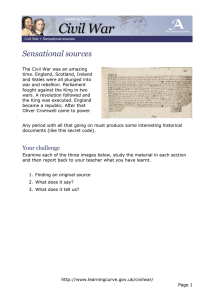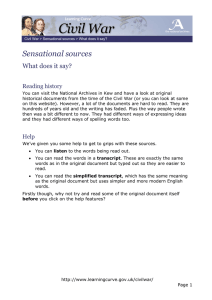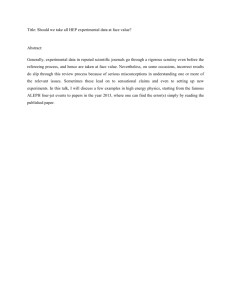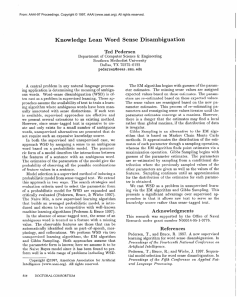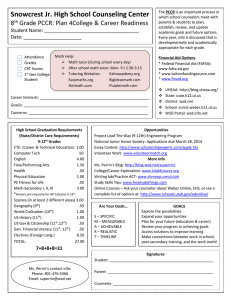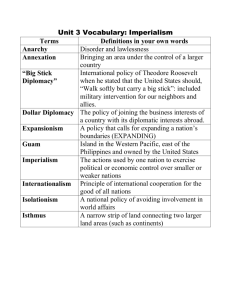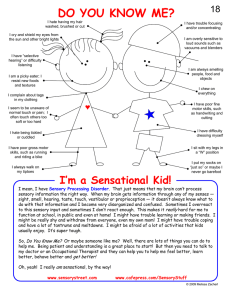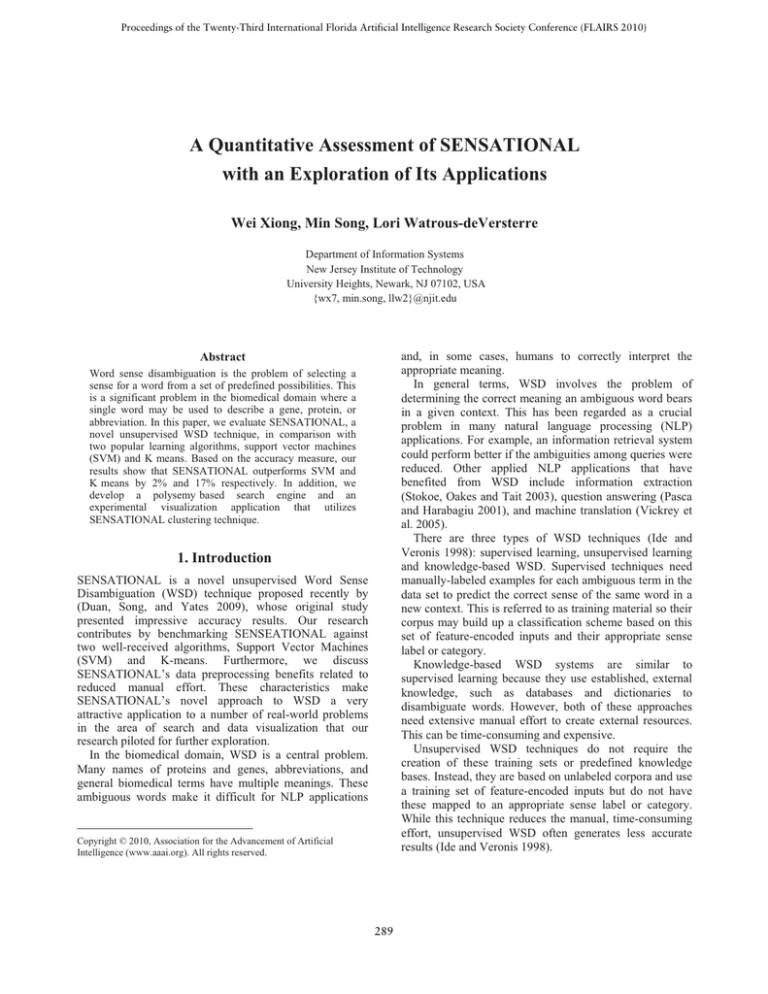
Proceedings of the Twenty-Third International Florida Artificial Intelligence Research Society Conference (FLAIRS 2010)
A Quantitative Assessment of SENSATIONAL
with an Exploration of Its Applications
Wei Xiong, Min Song, Lori Watrous-deVersterre
Department of Information Systems
New Jersey Institute of Technology
University Heights, Newark, NJ 07102, USA
{wx7, min.song, llw2}@njit.edu
and, in some cases, humans to correctly interpret the
appropriate meaning.
In general terms, WSD involves the problem of
determining the correct meaning an ambiguous word bears
in a given context. This has been regarded as a crucial
problem in many natural language processing (NLP)
applications. For example, an information retrieval system
could perform better if the ambiguities among queries were
reduced. Other applied NLP applications that have
benefited from WSD include information extraction
(Stokoe, Oakes and Tait 2003), question answering (Pasca
and Harabagiu 2001), and machine translation (Vickrey et
al. 2005).
There are three types of WSD techniques (Ide and
Veronis 1998): supervised learning, unsupervised learning
and knowledge-based WSD. Supervised techniques need
manually-labeled examples for each ambiguous term in the
data set to predict the correct sense of the same word in a
new context. This is referred to as training material so their
corpus may build up a classification scheme based on this
set of feature-encoded inputs and their appropriate sense
label or category.
Knowledge-based WSD systems are similar to
supervised learning because they use established, external
knowledge, such as databases and dictionaries to
disambiguate words. However, both of these approaches
need extensive manual effort to create external resources.
This can be time-consuming and expensive.
Unsupervised WSD techniques do not require the
creation of these training sets or predefined knowledge
bases. Instead, they are based on unlabeled corpora and use
a training set of feature-encoded inputs but do not have
these mapped to an appropriate sense label or category.
While this technique reduces the manual, time-consuming
effort, unsupervised WSD often generates less accurate
results (Ide and Veronis 1998).
Abstract
Word sense disambiguation is the problem of selecting a
sense for a word from a set of predefined possibilities. This
is a significant problem in the biomedical domain where a
single word may be used to describe a gene, protein, or
abbreviation. In this paper, we evaluate SENSATIONAL, a
novel unsupervised WSD technique, in comparison with
two popular learning algorithms, support vector machines
(SVM) and K means. Based on the accuracy measure, our
results show that SENSATIONAL outperforms SVM and
K means by 2% and 17% respectively. In addition, we
develop a polysemy based search engine and an
experimental visualization application that utilizes
SENSATIONAL clustering technique.
1. Introduction
SENSATIONAL is a novel unsupervised Word Sense
Disambiguation (WSD) technique proposed recently by
(Duan, Song, and Yates 2009), whose original study
presented impressive accuracy results. Our research
contributes by benchmarking SENSEATIONAL against
two well-received algorithms, Support Vector Machines
(SVM) and K-means. Furthermore, we discuss
SENSATIONAL’s data preprocessing benefits related to
reduced manual effort. These characteristics make
SENSATIONAL’s novel approach to WSD a very
attractive application to a number of real-world problems
in the area of search and data visualization that our
research piloted for further exploration.
In the biomedical domain, WSD is a central problem.
Many names of proteins and genes, abbreviations, and
general biomedical terms have multiple meanings. These
ambiguous words make it difficult for NLP applications
Copyright © 2010, Association for the Advancement of Artificial
Intelligence (www.aaai.org). All rights reserved.
289
Bayes classifier achieves a high level of accuracy using a
model of low complexity.
Decision list learning is a rule-based approach. (Frank
and Witten 1998) propose an approach for learning
decision lists based on the repeated generation of partial
decision trees in a ‘separate-and-conquer’ manner. They
demonstrate rule sets can be learned one rule at a time
without any need for global optimization. Decision Lists
were one of the most successful systems on the 1st
Senseval competition for WSD (Kilgarriff and Rosenzweig
2000).
Boosting approach is based on the observation that
finding many rough rules of thumb can be much easier
than finding a single, highly accurate predication rule
(Schapire 2003). (Escudero, Marquez and Rigau 2000)
apply the boosting algorithm to WSD problem, and
compare it with Naive Bayes and Exemplar-based
approaches. Their experiments on a set of 15 selected
polysemous words show that the boosting approach
outperforms its rivals.
To respond to the costly manual effort while maintaining
a high accuracy, (Duan, Song, and Yates 2009) proposed a
novel
unsupervised
WSD
technique,
called
SENSATIONAL. It uses a single parameter which is not
tied to the vocabulary thus making the resulting system
extendable to new terms. This means the system does not
have to be retrained when ported to a new document
collection. While the technique requires a small sample
data set for initialization, the effort is smaller compared to
supervised WSD techniques. SENSATIONAL is a
relatively new technique with limited literature to compare
it with other, more popular WSD techniques. Our object is
to compare SENSATIONAL with two well-received WSD
techniques, one of which is SVM, and the second which is
unsupervised, K-means.
The paper continues with a description of related work
in Section 2. In Section 3 we introduce the
SENSATIONAL algorithm for clustering word senses and
provide a search engine and an experimental visualization
application that utilizes this automatic clustering technique.
Section 4 outlines our experimental setup and presents
results. We discuss the future work for this ongoing
research in Section 5.
2.2. Unsupervised learning techniques
The K-means clustering (MacQueen 1967) is a common
clustering algorithm used to automatically partition a data
set into k groups. (Schütze 1998) proposed an
unsupervised technique for word sense disambiguation
based on a vector representation of word senses that were
induced from a corpus without labeled training instances or
other external knowledge sources. The K-means vector
model was used and demonstrated good performance of
context-group discrimination for a sample of natural and
artificial ambiguous words.
(Bhattacharya, Getoor and Bengio 2004) propose two
unsupervised WSD systems: ‘Sense Model’ and ‘Concept
Model’. Their experimental results show that the concept
model improved performance on the word sense
disambiguation task over the previous approaches
participated in 21 Senseval-2 English All Word
competition. (Yarowsky 1995) propose an unsupervised
learning algorithm to perform WSD, which is based on two
powerful constraints: that words tend to have one sense per
discourse and one sense per collocation. When trained on
unannotated English text, the experimental results indicate
that his algorithm is able to compete with some
unsupervised learning technique.
An unsupervised approach for WSD which exploits
translation correspondences in parallel corpora is presented
by (Diab and Resnik 2002). The idea is that words having
the same translation often share some dimension of
meaning, leading to an algorithm in which the correct
sense of a word is reinforced by the semantic similarity of
other words with which it shares those dimensions of
meaning. Based on fair comparison using community-wide
test data, the performance of their algorithm has been
evaluated.
2. Related work
In this section, we will review Word Sense Disambiguation
techniques that are widely used in the biomedical domain.
2.1. Supervised learning techniques
One of the most popular supervised learning techniques
used for WSD is Support Vector Machines (SVMs)
(Vapnik 1995). (Joshi, Pedersen, Maclin 2005) compare
SVM with other four well-known supervised learning
algorithms: Naïve Bayes, decision trees, decision lists and
boosting approaches on a subset of the NLM-WSD data set.
They converted the NLM formatted data into SENSEVAL2 format data which is an XML format with certain predefined markup tags. The statistical significance test of the
log likelihood measure was employed to identify bigrams
that occur together more often than by chance. Their
evaluation results indicated that SVM obtained the best
performance with unigram features selected using a
frequency cut-off of four.
Naïve Bayes is another popular supervised learning
technique widely used in biomedical domain. (Leroy and
Rindflesch 2005) use the naïve Bayes classifier from the
Weka data mining suite. Their experiments were
performed with incremental feature sets, thus evaluating
the contribution of new features over the previous ones.
They achieved convincing improvements over the majority
sense baseline in some cases, but observed degradation of
performance in others. A comparative study conducted by
(Pedersen and Bruce 1997) also shows that the Naïve
290
to a graph. After a weighted graph that represents the set of
mentions of an ambiguous term is built, the MST for the
graph is constructed, and the largest edge is removed from
it. This splits the graph into two clusters which can then be
further analyzed to determine if additional segmentation is
needed. The largest edge of the MST provides a large
margin between two clusters of the weighted graph. This
insight forms the basis of the SENSATIONAL algorithm.
One weakness with this algorithm is the potential for
outliers to skew the clusters. The SENSATIONAL system
corrects this from happening by finding the roots of all the
sub-trees and determines a path or backbone between these
sub-trees. This Backbone-Finding algorithm identifies the
core of the MST and helps prevent outliers skewing the
clusters that are developed.
The beauty of SENSATIONAL is that the algorithm
assumes essentially no input requiring significant manual
input to construct, such as manually-labeled training
examples for supervised learning algorithms or manuallyconstructed and manually-curated databases containing
structured knowledge. It needs a single free parameter,
which is essentially threshold that could be set by hand, but
also could be trained with only a few hundred manuallylabeled examples of one ambiguous term in context. This
parameter is not tied to the vocabulary, and the system
does not have to be retrained when ported to a new
document collection. This means, after being trained, the
system can be applied to any new term. We consider
SENSATIONAL as an unsupervised system because it is
common to refer to systems with a small number of free
parameters as “unsupervised” (Davidov and Rappaport
2008).
2.3. Knowledge-based WSD
The availability of extensive knowledge source such as
Unified Medical Language System (UMLS) and WordNet
has been widely utilized to tackle WSD problem.
(Widdows et al. 2003) propose their system for word sense
disambiguation of English and German medical documents
using UMLS. (Liu, Johnson and Friedman 2002) used
UMLS as the ontology and identified UMLS concepts in
abstracts and analyzed the co-occurrence of these terms
with the term to be disambiguated. (Leroy and Rindflesch
2005) studies the effect of different types of symbolic
information for terms in medical text by mapping
sentences to the UMLS. They use Naïve Bayes classifier to
disambiguate medical terms and the UMLS for its
symbolic knowledge. (Mihalcea and Moldovan 1998)
present a method for WSD that is based on measuring the
conceptual density between words using WordNet. (Inkpen
and Hirst 2003) use WordNet to disambiguate nearsynonyms in dictionary entries. Their approach is based on
the overlap of words in the dictionary description and the
WordNet glosses, synsets, antonyms, and polysemy
information.
3. SENSATIONAL and its Application
This section provides an overview of SENSATIONAL’s
clustering algorithm. It also suggests a polysemy-based
search engine and an experimental visualization
application that utilizes SENSATIONAL clustering
technique.
3.1. SENSATIONAL Clustering
3.2. Polysemy Extraction-based Search Engine
(Duan, Song, and Yates 2009) proposed a novel and
efficient graph-based algorithm to cluster words into
groups that have the same meaning. Their system, called
SENSATIONAL, is built on the principle of marginmaximization. This principle finds a surface in the space of
data points that separates the points in such a way that
maximizes the smallest distance between points on
opposite sides of the surface. Although it works accurately
and effectively, max-margin clustering is computationally
expensive.
To overcome this drawback, Duan et al. used a novel
approximation algorithm for finding max-margin clusters
in a document collection based on minimum spanning trees
(MST). A MST is an undirected graph that can be
computed efficiently and provides the smallest set of edges
in the tree to connect all the data points together. A second
characteristic of a MST is that for each data point, or node,
there will be exactly one path to every other node.
Therefore, we can divide a MST into sub-graphs by simply
removing one edge.
To use MST in max-margin cluster, each word in a set
of documents containing that word is stored in an index,
which can be used to prune the set of edges that are added
SENSATIONAL’s benchmarking results and data
preprocessing features make it a very attractive technique
for a number of real-world problems. The following
described a prototype of two novel approaches to search
and data visualization.
In the case of search, it is well known that as our corpora
continually grow, the current retrieval systems, modeled
after card catalog systems, will become cumbersome and
inefficient (Korfhage 1991). New ways to determine what
end-users are searching for need to be developed that don’t
just present all possible query keyword matches, but also
attempts to provide them with information to support
iterative search requests that will isolate the documents
relevant to their particular inquiry. This iterative 3-step
process starts with a broad query which, in successive
queries drills-down by either zooming in on wanted
concepts or filtering out unwanted concepts. Finally details
on specific content are examined and the process begins
again (Koshman 2006).
Users search for different reasons. Two basic purposes
are to find explicit information and to perform exploratory
291
end with an overall count of the number of documents
associated with the topic id. Since documents may have an
overlap between these subtopics, the Cluster Map shows
this by color coding the groupings and indicating an
overlap by having the connecting pathways having the
different colors. In the case of label 2, all the documents
are also grouped within label 3 while label 1’s document
set has 7 of its documents overlapping with subtopic 3 and
a single outlier shown at the bottom of the display not
associated at all.
browsing. When searching for explicit information, we
may or may not know the specific terms to use. Initial
results returned must be examined and if inadequate
summaries provided, the user must open up documents and
examine content. This can be time consuming and
frustrating. Exploratory browsing can be even worse. As a
user moves from document to document, the “bigger
picture” or reason for the browsing can soon be forgotten
leading to wasted time and effort. Even worse, potential
new discoveries can be hidden in the maze of lengthy lists
of keyword matched content.
An exploratory polysemy extraction-based search engine
was built to determine if SENSATIONAL could be used to
identify clusters based on existing corpora. Preliminary
results show we can identify the clusters via the BackboneFinding algorithm and present topical terms.
The following example is a visual representation for the
query “cold”. A search was conducted on the PubMed
collection using the query, “cold”. A limit was placed on
the search to retrieve up to 300 documents. The polysemybased search engine identified 4 different senses. Figure 1
is a display of the results which shows the number of
resources associated with each sense along with a machine
generated meaning of the sense based on latent semantic
indexing. For example, the first sense, labeled, “vitamin
common cold revisited”, includes 148 documents related to
managing a common cold while the second sense contains
11 documents describing an object used for pain relief.
This display can help a user focus their search which can
reduce the amount of content an individual must examine.
It may also help a user determine if a repository contains
the type of content they are interested in. For users
performing an explicit or exhaustive search, this format
also provides information on additional appropriate terms.
Figure 2. Visual representation of SENSATIONAL
generated terms in existing corpora
This display not only identifies all the topical terms for a
query but their inter-relationship within the collection
being searched. This visual representation may help users
understand meaning and relationships of ambiguous terms.
For users unfamiliar with the multiple meanings of a term
or performing exploratory browsing, this high-level
overview provides an organizational structure to help users
focus on the intent of their search before opening any
documents to determine if it meets their needs or not.
4. Experiment and results
We performed an experiment to compare SENSATIONAL
system against both SVM and K-means.
4.1. Experimental Setup
We evaluated SENSATIONAL, SVM and K-means on the
same data set that (Duan, Song, and Yates 2009) used to
evaluate SENSATIONAL and we show their results below.
The data set of keywords is from the National Library of
Medicine (NLM) data set, plus a set of additional terms,
including a number of acronyms. They collected a data set
of PubMed abstracts for these terms. On average, 271
documents per keyword were collected; no keyword had
fewer than 125 documents, and the largest collection was
503 documents. They filtered out abstracts that were less
Figure 1. Two-level search results display
If a user decides they are interested in information about
managing the common cold they can drill down to discover
the Cluster Map shown in Figure 2. The Map shows 3
subtopics which are defined in the ovals beginning with the
topic identifiers 1, 2, and 3. The identifiers are followed by
a set of terms generated by latent semantic indexing and
292
than 15 words and manually labeled each occurrence of
each term with an identifier indicating its sense in the
given context. They collected data for a total of 21
keywords. Two of these were used for training, and the
other 19 for tests.
We used LIBSVM by Chih-Chung Chang and Chih-Jen
Lin
(available
for
download
at
http://www.csie.ntu.edu.tw/~cjlin/libsvm). (Xu et al. 2006)
applied SVM classifiers to perform WSD tasks on an
automatically generated data set that contains ambiguous
biomedical abbreviations. Their results indicated that there
was no statistical difference between results when using a
five-fold or ten-fold cross-validation method. In our case,
for SVM we adopted the linear kernel and default
parameter values, and ran a five-fold cross-validation.
It is interesting to notice that some ambiguous words
were more troublesome to the classifiers than others. Most
words only had 2 senses in the data, with four exceptions:
“BPD”, “cold”, “inflammation”, and “nutrition” had 3
senses each. The WSD performance of these exceptions
was generally poorer than others, which confirmed that the
number of senses could be one of the determinants of the
word ambiguity (Leroy and Rindflesch 2005).
5. Discussion and future work
We evaluated SENSATIONAL, a novel unsupervised
WSD technique, in comparison with two popular learning
algorithms, SVM and K-means. We manually curated the
data set collected from National Library of Medicine
(NLM). In addition, we develop a polysemy-based search
engine and an experimental visualization application that
utilizes SENSATIONAL clustering technique. These
applications could help users understand the meaning and
relationships of ambiguous terms, choose their next level
of search and reduce the amount of content the individuals
must wade through to find what is relevant to them.
The experiment that we have performed demonstrated
that compared with K-means, SENSATIONAL is able to
achieve a better accuracy. It outperforms K-means by 17%.
However, compared with SVM, the performance of
SENSATIONAL is not statistical significant, given that the
significance level p=0.495. In addition, the performance of
SVM could be improved by optimizing its parameter
values.
So far the performance of SENSATIONAL is very
encouraging, given that it assumes essentially no inputs
that require significant manual input to construct.
SENSATONAL’s Max-margin technique combined with
its Backbone-Finding algorithm is not only able to
outperform the state-of-the-art unsupervised WSD
technique, but also competitive against supervised learning
algorithm. In future work, we plan to examine if the good
performance of SENSATIONAL in medical domain will
translate into general English word sense disambiguation,
especially compared with other well-known machine
learning algorithms.
4.2. Results
We evaluated SENSATIONAL against SVM and K-means
based on the standard measure of accuracy, which is the
percentage of the correctly classified instances.
Results for our comparison appear in Table 1.
SENSATIONAL is able to outperform both SVM and Kmeans, by 2% and 17% on average across the keywords
respectively. Considering that the size of our data set of
keywords is smaller than 30, we performed K-S test for
normality of distributions and the results (significance
level > 0.05) suggest that the distributions are normal. The
performance of SENSATIONAL compared to K-means
and SVM is statistically significant at p<0.05 and p=0.495
respectively, using a paired t-test.
Table 1: Comparison with SVM and K-means
Keyword
ANA
BPD
BSA
CML
cold
culture
discharge
fat
fluid
glucose
inflammation
inhibition
MAS
mole
nutrition
pressure
single
transport
VCR
average
SVM
0.82
0.97
0.99
0.99
0.68
0.59
0.71
0.51
0.92
0.51
0.42
0.50
1.0
0.78
0.53
0.82
0.95
0.51
0.80
0.74
K-means
0.72
0.42
1.0
0.60
0.45
0.58
0.43
0.53
0.60
0.58
0.45
0.67
0.51
0.53
0.44
0.68
0.84
0.52
0.64
0.59
Sensational
1.0
0.53
0.95
0.90
0.67
0.82
0.95
0.53
0.99
0.51
0.50
0.54
1.0
0.96
0.55
0.86
0.99
0.57
0.64
0.76
6. References
Duan, W., Song, M. and Yates A. 2009. Fast max-margin
clustering for unsupervised word sense disambiguation in
biomedical texts. BMC Bioinformatics 10: S4.
Ide, N., and Véronis, J. 1998. Introduction to the special
issue on word sense disambiguation: the state of the art.
Computational linguistics 24: 2–40.
Stokoe, C.; Oakes, M. P.; and Tait, J. 2003. Word sense
disambiguation in information retrieval revisited. In
Proceedings of the 26th annual international ACM SIGIR
293
conference on Research and development in informaion
retrieval 166.
Pasca, M. and Harabagiu, S. 2001. The informative role of
WordNet in open-domain question answering. Workshop
on WordNet and Other Lexical resources at NAACL.
Vapnik, V. 1995. The Nature of Statistical Learning
Theory. Spring, New York.
Vickrey, D.; Biewald, L.; Teyssier, M.; and Koller, D.2005.
Word-sense disambiguation for machine translation. In
Proceedings of HLT/EMNLP vol. 5.
Joshi, M.; Pedersen, T.; and Maclin, R. 2005. A
comparative study of support vector machines applied to
the supervised word sense disambiguation problem in the
medical domain. In Proceedings of the 2nd Indian
International Conference on Artificial Intelligence
(IICAI’05), 3449–3468.
Leroy, G., and Rindflesch, T. C. 2005. Effects of
information and machine learning algorithms on word
sense disambiguation with small datasets. International
Journal of Medical Informatics 74: 573–585.
Pedersen, T., and Bruce, R. 1997. Knowledge lean wordsense disambiguation. In Proceedings of the National
Conference of Artificial Intelligence, 814–814.
Frank, E., and Witten, I. H. 1998. Generating accurate rule
sets without global optimization. In Proceedings of the
Fifteenth International Conference on Machine Learning,
144–151.
Kilgarriff, A., and Rosenzweig, J. 2000. English
SENSEVAL: Report and results. LREC, Athens, 265–283.
Schapire, R. E. 2003. The boosting approach to machine
learning: An overview. LECTURE NOTES IN
STATISTICS NEW YORK SPRINGER VERLAG, 149–172.
Escudero, G.; Marquez, L.; and Rigau, G. 2000. Boosting
applied to word sense disambiguation. In Proceedings of
ECML 00, 11th European Conference on Machine
Learning (Barcelona, Spain, 2000), 129–141.
MacQueen, J. B. 1967. Some methods for classification
and analysis of multivariate observations. In Proceedings
of 5th Berkeley Symposium on Mathematical Statistics and
Probability, 281-297.
Schütze, H. 1998. Automatic word sense discrimination.
Computational Linguistics 24: 97–123.
Bhattacharya, I.; Getoor, L.; and Bengio, Y. 2004.
Unsupervised sense disambiguation using bilingual
probabilistic models. Proceedings of the Meeting of the
Association for Computational Linguistics.
Yarowsky, D. 1995. Unsupervised word sense
disambiguation rivaling supervised methods. In
Proceedings of the 33rd annual meeting on Association for
Computational Linguistics 189–196.
Diab, M. and Resnik, P. 2002. An unsupervised method for
word sense tagging using parallel corpora. Proc. ACL.
Wilks, Y.; Fass, D.; Guo, C.; MacDonald, J.; Plate, T.; and
Slator, B. 1990. Providing Machine Tractable Dictionary
Tools, MIT Press.
Harley, A., and Glennon, D. 1997. Sense tagging in action.
In Proceedings of SIGLEX Workshop on Tagging Text with
Lexical Semantics: Why, What and How.
Humphrey, S. M.; Rogers, W. J.; Kilicoglu, H.; DemnerFushman D.; and Rindflesch, T. C. 2006. Word sense
disambiguation by selecting the best semantic type based
on Journal Descriptor Indexing: Preliminary experiment. J.
Am. Soc. Inf. Sci. 57: 96-113.
Widdows, D.; Peters, S.; Cederberg, S.; Chan, C. K.; and
Steffen, D. 2003. Unsupervised monolingual and bilingual
word-sense disambiguation of medical documents using
UMLS. In Proceedings of the ACL 2003 workshop on
Natural language processing in biomedicine Volume 13 9–
16.
Liu, H.; Johnson, S. B.; and Friedman, C. 2002. Automatic
resolution of ambiguous terms based on machine learning
and conceptual relations in the UMLS. Journal of the
American Medical Informatics Association 9: 621.
Mihalcea, R., and Moldovan, D. 1998. Word sense
disambiguation based on semantic density. In Proceedings
of COLING/ACL Workshop on Usage of WordNet in
Natural Language Processing 16–22.
Inkpen, D. Z., and Hirst, G. 2003. Automatic sense
disambiguation of the near-synonyms in a dictionary entry.
Lecture Notes in Computer Science 258–267.
Xu, H., Markatou, M.; Dimova, R.; Liu, H.; and Friedman,
C. 2006. Machine learning and word sense disambiguation
in the biomedical domain: design and evaluation issues.
BMC bioinformatics 7: 334.
Davidov, D. and Rappaport, A. 2008 Unsupervised
Discovery of Generic Relationships Using Pattern Clusters
and its Evaluation by Automatically Generated SAT
Analogy Questions. Proceedings of the Annual Meeting of
the Association of Computational Linguistics.
Korfhage, R.R. 1991. To see, or not to see – IS that the
query? Proceedings of the 14th annual international ACM
SIGIR conference on Research and development in
information retrieval, ACM: 134-141.
Koshman, S. 2006. Visualization-based information
retrieval on the Web. Library & Information Science
Research 28(2): 192-207
294

